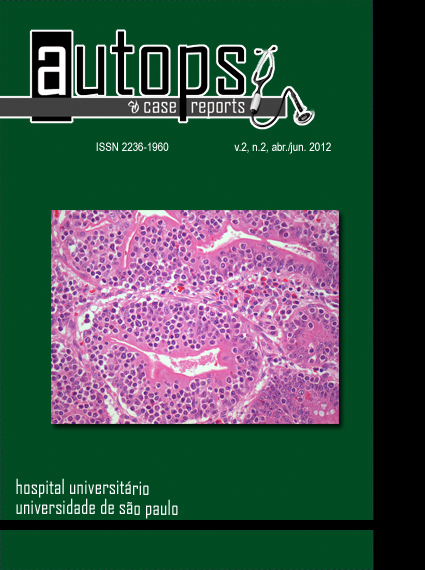Using the Graf method of ultrasound examination to classify hip dysplasia in neonates
DOI:
https://doi.org/10.4322/acr.%25y.36456Keywords:
Hip Dislocation, Ultrasonography, Congenital Abnormalities, Infant, Newborn.Abstract
Developmental dysplasia of the hip (DDH) is one of the most common congenital orthopedic anomalies. Ultrasound examination employing the Graf method is used to diagnose DDH. We conducted a retrospective cross‑sectional study of 222 neonatal patients (140 females and 82 males) submitted to ultrasound examination of the right and left hips between January of 2009 and May of 2011. The mean age was 5.0 days. The patients were grouped by laterality, mean alpha (α) and beta (β) angles (in degrees), and hip type (as determinedby the Graf classification). The data collected were statistically correlated.
Mean α angle values were higher in males than in females, as well as being higher for right hips than for left hips (p < 0.001). In contrast, mean β angle values were lower in males than in females, as well as being lower for right hips than for left hips (p < 0.001). Type Ia hips (i.e., mature hips) predominated
in both genders and on both sides, having been found in 82.32% of the examinations of males and in 71.09% of those of females. The right hip was classified as type Ia in 78.38% of the examinations, and the left hip was classified as type Ia in 72.07%. Type IIa hips (i.e., immature hips) were found in 12.8% of the examinations of males and in 20% of those of females. The right hip was classified as type IIa in 13.96% of the examinations, and the left hip was classified as type IIa in 20.72%. The remaining hip types were less common. We emphasize the importance of ultrasound as a standard method
of screening for DDH.
Downloads
Download data is not yet available.
Downloads
Published
2012-06-08
Issue
Section
Autopsy Case Report
License
Copyright
Authors of articles published by Autopsy and Case Report retain the copyright of their work without restrictions, licensing it under the Creative Commons Attribution License - CC-BY, which allows articles to be re-used and re-distributed without restriction, as long as the original work is correctly cited.
How to Cite
Jacobino, B. de C. P., Galvão, M. D., da Silva, A. F., & de Castro, C. C. (2012). Using the Graf method of ultrasound examination to classify hip dysplasia in neonates. Autopsy and Case Reports, 2(2). https://doi.org/10.4322/acr.%y.36456



